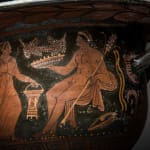Apulian red-figure bell crater, 400 to 300 BCE
26 x 31 cm
10 1/4 x 12 1/4 in
10 1/4 x 12 1/4 in
CB.72
Further images
The archaeology of ancient Apulia (the south-eastern tip of the Italian peninsula) has remained in relative obscurity until the last few decades. Apulian vase painting though happens to be a...
The archaeology of ancient Apulia (the south-eastern tip of the Italian peninsula) has remained in relative obscurity until the last few decades. Apulian vase painting though happens to be a better studied sector, divided into two main categories: Apulian geometric pottery and Apulian red figure pottery.
Apulian red-figure ceramics was the leading South Italian vase painting practice between 430 and 300 BC. Of the more or less 20,000 existent South Italian red-figure vases, half are of Apulian production, while the remaining originate from the four other main production-centres: Paestum, Campania, Lucania and Sicily.
The main production centre was Taras, the only large Greek polis in Apulia, out of which emerged two main styles of decoration, the "Plain Style" and the "Ornate Style" (also know as "Rich Style"). The first largely avoids any additional colouring and was mostly used for the decoration of bell and column craters and vessels of rather small proportions. The decoration remains throughout quite simple, with groups usually of one to four figures, while the decorative motifs mainly focus on mythological imagery. The back and secondary sides of the kraters usually depict cloaked youths. In the second half of the 4th century, the Plain Style became increasingly similar to the ornate one. The ceramists of the Ornate Style had a distinct preference for vessels of larger dimensions, with space for larger and complicated compositions, such as volute kraters, amphorae, loutrophoroi and hydriai. Compositions contained up to 20 figures, often arranged in two or more registers. The figures frequently appear to be floating on the background. Colouring was used copiously, especially red, gold/yellow and white.
A large number of these vases were specifically created as grave offerings and many of the scenes have themes related to the entourage of Dionysus or Aphrodite, and are thus directly connected to certain local funerary traditions and cults, where the ideas of an afterlife is frequently implied or even directly expressed. Naked male figure of monumental proportions, seated on the drapery of his himation, crowned, holding a thyrsos on the left hand and a kalathos on the extended right, faces a female figure in rapid movement, richly dressed and bejeweled, carrying a chest and a bucket. The scene with all probability depicts Adonis, a popular figure at the time, during the Adonia, a private rather than state festival, exclusively celebrated by women mourning the death of Adonis.
On the reverse, two figures of youths in conversation, each draped in himation and holding a staff.
Apulian red-figure ceramics was the leading South Italian vase painting practice between 430 and 300 BC. Of the more or less 20,000 existent South Italian red-figure vases, half are of Apulian production, while the remaining originate from the four other main production-centres: Paestum, Campania, Lucania and Sicily.
The main production centre was Taras, the only large Greek polis in Apulia, out of which emerged two main styles of decoration, the "Plain Style" and the "Ornate Style" (also know as "Rich Style"). The first largely avoids any additional colouring and was mostly used for the decoration of bell and column craters and vessels of rather small proportions. The decoration remains throughout quite simple, with groups usually of one to four figures, while the decorative motifs mainly focus on mythological imagery. The back and secondary sides of the kraters usually depict cloaked youths. In the second half of the 4th century, the Plain Style became increasingly similar to the ornate one. The ceramists of the Ornate Style had a distinct preference for vessels of larger dimensions, with space for larger and complicated compositions, such as volute kraters, amphorae, loutrophoroi and hydriai. Compositions contained up to 20 figures, often arranged in two or more registers. The figures frequently appear to be floating on the background. Colouring was used copiously, especially red, gold/yellow and white.
A large number of these vases were specifically created as grave offerings and many of the scenes have themes related to the entourage of Dionysus or Aphrodite, and are thus directly connected to certain local funerary traditions and cults, where the ideas of an afterlife is frequently implied or even directly expressed. Naked male figure of monumental proportions, seated on the drapery of his himation, crowned, holding a thyrsos on the left hand and a kalathos on the extended right, faces a female figure in rapid movement, richly dressed and bejeweled, carrying a chest and a bucket. The scene with all probability depicts Adonis, a popular figure at the time, during the Adonia, a private rather than state festival, exclusively celebrated by women mourning the death of Adonis.
On the reverse, two figures of youths in conversation, each draped in himation and holding a staff.











